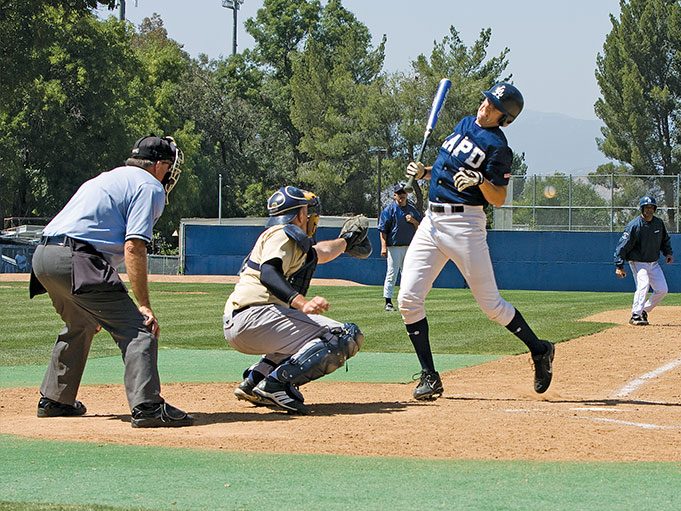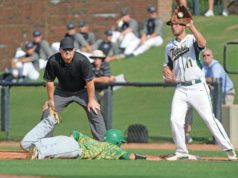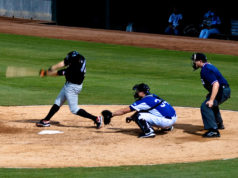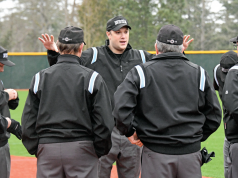The earliest umpires didn’t have much of a decision to make when a batter was hit by a pitch. A pitch hitting the batter’s hands, as well as his forearm, was simply a dead ball with no award of first base. Modern umpires have a greater challenge, especially since each of the major codes has its own wording on when a struck batter goes to first or stays home. Except where noted, the material applies equally to NFHS, NCAA and pro rules.
The scenarios that are least problematic are when the pitch is a strike. That occurs when either the batter swings at the ball as he is hit or the pitch is in the strike zone when it hits the batter. In either case, the ball is dead, no runners can advance and a strike is called. If it’s the third strike, the batter is out (NFHS 5-1-1a, 7-2-1b, 8-1-1d1; NCAA 6-4c, 8-2d1; pro 5.05b2).
If the pitch is not a strike, there is one additional condition that must be met before the umpire should allow the batter to trot off to first base. Although the wording differs among the codes, an umpire would not be wrong if they were to judge hit batsmen the same regardless of the rules under which the game was being played.
NFHS rules state a plunked hitter is awarded first base unless he permits the pitch to hit him. That implies the batter must attempt to get out of the path of the ball, which happens to be the NCAA and pro wording. If we turn those words around, a batter does not make an attempt to avoid getting hit (NCAA/pro wording) if he permits the pitch to hit him (NFHS wording).
Rather than focusing on the exact wording, seeking a loophole as an attorney would, an umpire should concentrate on developing the guidelines he will use to make the stay or go decision. It is the umpire’s responsibility to determine whether or not the batter could have feasibly avoided the pitch. In this matter, “movement” is not synonymous with “avoid.” It is unrealistic to expect batters to protect the plate and not subject themselves to being hit. The indicators umpires can use in making that determination include the speed, the type and the location of the pitch in relation to both the plate and the batter’s position. Where on the batter’s body the ball makes contact is also a factor. Keep in mind, a batter who has committed to swinging has reduced the control of his body.
It is not feasible to cover all the possibilities, and putting this subject into “rules” is highly likely to spur disagreement, but what follows should get any umpire started on determining what he or she should look for. Fastballs are very difficult to avoid, especially when thrown directly at or behind the batter. It’s easy to say a batter can move toward the plate if the pitch is at his back, but that is not a natural movement. Twisting the upper torso to avoid the pitch generally should be accepted as sufficient movement, but it’s possible to manipulate the upper body so as to be hit. It takes more time to decide to move the feet. It is possible for a batter to “freeze” and get struck by the pitch. If he couldn’t reasonably have moved, he didn’t “permit” the pitch to hit him, and if you accept “must attempt to avoid” means “could have feasibly attempted,” then all codes are satisfied.
Pitchers have a wide variety of breaking balls at their disposal and the late movement of the ball is also a factor. If the umpire is surprised at the ball’s movement, it’s likely the batter was just as shocked.
Balls thrown at the upper torso and the buttocks are more difficult to avoid than those in front of the batter. The arms are the easiest body part to control. A batter who gets hit on a foot can generate considerable debate. One thought is a foot is relatively easy to move and there is an apparent motive of purposely taking a relatively painless shot to get on base. On the other hand, the last thing a batter wants to move is his feet; doing so eliminates a credible swing. It’s also very difficult to track a pitch that low. Finally, philosophy-wise, such a pitch is really poor and not many have sympathy for a pitcher who has radically missed the strike zone. While exceptions are inevitable, as a rule of thumb, a plop on the foot gets the batter to first.
There are some easy ones for umpires. It can be pretty obvious when the batter is letting himself get hit — “the old chicken wing.” The classic is perhaps the slow curve ball that ticks the batter’s front sleeve. The hands, though, are a totally different issue. First, we can dispel the myth the hands are part of the bat. That has never been the rule, but just about every umpire hears it at least once a year. Defensive coaches will argue that a pitch that hits a batter’s hands is a foul ball. The only correlation is the ball is indeed dead. Many players who don’t swing and are struck on the hands by a ball outside the zone don’t realize their entitlement and remain in the box for the next pitch. A dispute is almost inevitable and there will not always be clear evidence.
If the pitch hits the batter’s hands, it is highly likely to be a hittable pitch. The batter cannot be faulted when his fingers are cropped or the hand/wrist area is pelted; those are all fairly painful. The bigger challenge is figuring out if the hands or the bat were hit. Hearing the sound of the ball hitting the bat is not a foolproof clue because both could be hit simultaneously or the ball could hit the hand and deflect to the bat. Having a batter take off his batting glove to check for welts is permissible. When in doubt, the ball hit the hand. The umpire also has to determine if a swing occurred and that may require an appeal to a base umpire.
Only NFHS rules address a batter’s loose garment, such as a shirt that is not worn properly (8-1-1d2). No base award is made in those cases. The tick of the ball on a loose jersey is a challenge to any umpire’s eyesight. Both batter and ball may be moving when that occurs. Those are usually cases where the view from the offensive dugout is much better than from behind the plate. It’s a good idea here to apply “circumstantial evidence.” In other words, let the actions of the batter guide the decision, especially if he shows no reaction to being touched by the ball.
A pitch that hits in the dirt before touching the batter does not change anything. Coaches have been known to argue that the ball hitting the ground erases the batter’s entitlement. What does erase the claim to first, though, is a pitch that deflects off the catcher or umpire before it touches the batter. In such a case, the ball remains live and in play, runners may advance and the batter is not entitled to any base. Interestingly, you won’t find that spelled out in any rulebook.
In closing, by default a batter is awarded first base when he is struck by a pitch and he gets the benefit of any doubt. Here are some plays with common scenarios.
Play 1: F1 throws a fastball down the middle of the batter’s box. B1 is caught flat-footed and the ball strikes him in the middle of the back. Ruling 1: B1 is a hit batsman since he did not swing at the pitch. He is awarded first.
Play 2: B1 takes a stance leaning over the plate. The pitch is high near the inside edge of the plate. B1 freezes and allows the pitch to hit the top of his shoulder that is out of the batter’s box. Ruling 2: The ball is dead and is a ball. B1 is not awarded first.
Play 3: With a runner on first, B1 anticipates a curve on a 1-0 count and holds his ground. The ball breaks, but hits B1 on the wrist in the strike zone. Ruling 3: The ball is dead and B1 remains at bat with a 1-1 count. R1 remains at first.
What's Your Call? Leave a Comment:
Note: This article is archival in nature. Rules, interpretations, mechanics, philosophies and other information may or may not be correct for the current year.
This article is the copyright of ©Referee Enterprises, Inc., and may not be republished in whole or in part online, in print or in any capacity without expressed written permission from Referee. The article is made available for educational use by individuals.


















